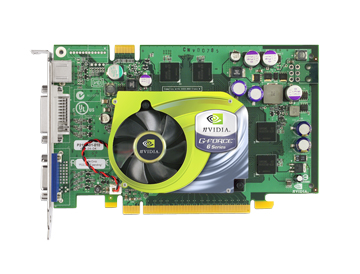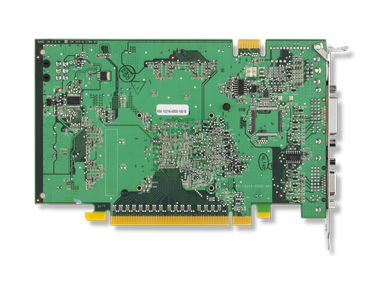NVIDIA GeForce 6600 GT: Bringing NV4x to the Masses
by Derek Wilson on September 7, 2004 9:00 AM EST- Posted in
- GPUs
High-Tech Mid-Range
The 6600 series of GPUs (NV43) are based on the NV40 core architecture. The entire feature set from the 6800 line is carried over with only a few exceptions. First, the memory bandwidth of the card is cut from 256 down to 128. This should have a fairly large impact on AA/AF performance and other very graphics memory intensive operations. The second adjustment NVIDIA includes in NV43 is a reduction in the maximum number of supported pixel pipelines. 6600 series cards have 8 pixel pipelines. This is half the max of the NV40 core.Of course, we can also look at NV43 as the same number of pipelines as a 9800XT, and twice the pipelines in a 5950 Ultra. This, and the 500 core and 500 memory clock speeds, make the 6600 GT a very formidable contender on paper. For anyone interested, AnandTech has recently published an article detailing the theoretical maximums (among other things) of just about every ATI and NVIDIA card since Radeon and GeForce were first introduced. Higher theoretical fill rates and processing power are always nice things to see, but can the card deliver?

The 6600 GT also features one of the most exciting aspects of the NV4x series of GPUs: SLI. We've covered NVIDIA's take on SLI before, and we are happy to see it making its way down the line of NV GPUs. Obviously, one would not get the same power from 2x $200 cards than from 2x $500 cards, but dropping the price on an SLI capable card is really opening the door to those who would like to see some sort of upgradeability maintained in today's ever changing scene.

We haven't yet gotten our hands on a regular 6600, but traditionally, the $200 parts have been the sweet spot for price/performance ratios. That's not to say that the 6600 won't be a good deal, but NVIDIA will have to be careful to push clock speeds that don't offer a (much?) lower value. We would have dropped the clock on our 6600 GT to match 6600 speeds, but they use different memory types. We'll have to wait until we can get our hands on one of those to see some performance numbers.
It is worth mentioning that neither the 6600 nor the 6600 GT require an external power source. That isn't to say that they are less power hungry than an AGP card that requires external power, but that the PCI Express slot supplies enough voltage to the card that it doesn't need any more juice. PCI Express is designed to be more robust in that area than AGP.
There's not much else to say other than to reiterate that the 6600 series sport the same feature set (barring the exceptions mentioned) as the original NV40 GPUs. So, without further ado, we present the benchmarks.










44 Comments
View All Comments
SuperDuper28 - Monday, September 13, 2004 - link
Anyone got any info on release date?Only thing I have seen is "sometime in Sep" but I don't see any place to preorder or any manufactuers advertising it.As far as benchmarks.I don't care how much memory it has,how many pipes,how many bits,what the core and memory is clocked at...ect,I've seen lots of different benches and different sites with different rigs and in all of them it performs close to a 6800 and 800x and in some cases slightly outperformed.I don't know how to explain it but thats the way it is and $200 for this card compared to $400+ for the others is a no brainer.
Thatguy97 - Saturday, May 9, 2020 - link
Corona will kill us allJarredWalton - Thursday, September 9, 2004 - link
Actually, mickyb, it's not so much that NVIDIA neglected DX9 performance as it is ATI neglecting OpenGL performance. If a game doesn't make any use of the special features of the GF6 cards (i.e. SM3.0 extensions), the X800 XT PE has a very large advantage in pixel rates and vertex rates. They're both 16x1 pixel and 6 vertex designs, but the ATI card runs at 520 MHz compared to 450 MHz on the 6800UE. That's a 15% performance advantage in clock speed, which correlates pretty well with the Source Stress Test results. So, I agree with you to a point, but really ATI just needs to get their OpenGL drivers up to par.mickyb - Wednesday, September 8, 2004 - link
**** WARNING: RANT ****I am spending way too much time on this article, but everytime I read the benchies on the 6800 and X800 series, I keep asking what is going on with NV and DirectX and ATI and Open GL? I have a hard time believing that the two APIs are so different that the hardware has to be designed for them. I think NV spent way too much time in the closet with Quake III and ATI in their closet with HL-2. Both engines are going to have an presence in other games and I don't want to have to pick a video card for the games that I play. If this continues, it will turn into the same war that the consoles have. I chose a PC so I can play all games. Maybe this will all correct itself after the next driver releases.
JarredWalton - Wednesday, September 8, 2004 - link
I don't have any insider information, and I haven't signed any NDA's, so I can say that NF4 is probably due out within the next few months. That could be wrong, of course.There will be a 6600 vanilla part, Visual, but due to the use of different RAM and other factors, we do not have benches for that yet. It was mentioned on the second page, forth paragraph. I'm sure they're coming soon.
Finally, regarding the 6800 vanilla vs. 6600GT, there are two things to consider. First, how much faster is the 6800 when running on the same system? Generally, it is slightly faster and up to 20% faster when the system is essentially the same, so 50% more for up to 20% performance probably isn't worth it to most people. The bigger problem, however, is that the 6600GT is a PCIe part. There should be AGP bridged versions in the future, but how far off are they? After the "paper launch" of the X800 and 6800 cards, I wouldn't expect an AGP 6600GT for another six weeks at best.
I wouldn't be surprised to see NF4 and SLI and 6600GT all reach widespread availability around the same time. Well, that's what I would try to shoot for if I were Nvidia, anyway. If NF4 gets delayed due to technical issues, though, who knows?
Visual - Wednesday, September 8, 2004 - link
Oooh, reading mickyb's post, imagining two of these things each with a TV tuner, with the SLI bridge between them... mmmm :)The 3d performance would be perfect for today, and you'd have 4 monitors (or 2 monitors/2tvs) max.. if it could work without disabling NF4's IGP, 5/6 monitors, just trashing ATI's hyrdaview!
Two tuners giving you picture in picture or recording independently of what you're watching... Or one of the cards can be with digital tuner the other with analog... there'd be something for everyone :)
I'm drooling :)
Visual
P.S. Quite off-topic, but what's know about nVidia's plans for NF4, and is it expected soon?
Visual - Wednesday, September 8, 2004 - link
Seeing this card named "GT" I wonder if there will be cheaper versions of it... any info on that from nVidia?It'd be good to see a comparison between this card, the cheaper x600XT and the bit more expencive vanilla 6800, all on the same system. I'm pretty sure you guys won't bother to make another article for this, but at least if you see something on the web I hope you'll post in the news section :)
Also I wonder if the 6800 is worth the extra cash in your oppinion. I was almost decided on getting one but this article makes me consider waiting again...
Thanks for the article,
Visual
mickyb - Wednesday, September 8, 2004 - link
Not sure any of this is viable, but going along with my previous comment, this looks like it would be a good candidate for SFF systems. It provides good performance at the right price. Furthermore, it supports SLI. For non-SFF systems, it is a nice way to incrementally get to the performance needs that your game requires. Practically, it is always a challenge to incrementally approach any performance target, because when you are ready to step up, it is time to get a whole new system. Allright, back to SFF. It would be cool if this was the onboard graphics candidate for NF4. This chip coupled with Video-in and it could finally compete with ATI in the AIW space. Currently I would always go for ATI, due to having to make the performance vs. all round use decision. Now here is where I think NV could have something. Since this chip supports SLI, it would be really something if the NF4 had this video on-board and if you wanted a little more power, you just add another card. I don't know about you all, but I don't like buying a nice MB just to have to disable an almost passable video card because it couldn't run the next game.JarredWalton - Wednesday, September 8, 2004 - link
First, perhaps the disclaimer wasn't big enough, but running the tests on different platforms is never an optimal solution. This can and will affect the results in various instances. A 3400+ is a very fast chip, but the 3.4 GHz P4EE is still going to beat it in many situations. However, going back and running hundreds of benchmarks on different platforms really isn't an option. At some point in the future, I'm sure there will be a more equal roundup of the cards, but it's just an approximate measurement of performance anyway.If you look at the "performance estimates" in the GPU Cheatsheet article we recently published, you can see some additional support for why the 6600 GT would sometimes beat the 6800 vanilla. In pixel performance, the raw clockspeed of the 6600GT puts it just a fraction faster than the 6800, while it's slower in bandwidth by a relatively large amount. They're also pretty close in vertex processing power. Change the CPU from a 2.2 GHz 1MB L2 A64 to a 3.4 GHz 2 MB L2 P4EE and the closeness of the cards can end up pushing the GT ahead in cases where the P4EE is faster.
(I may have the wrong number of vertex pipelines as well, which could mean that the 6600GT has substantially more vertex processing power. Any word on that Derek? I had 3 vertex pipelines as "rumor" on the 6600 chips, but the benchmarks seem to indicate that it might have more.)
Without knowing the internal structure of the chips and cards, we can't say for sure, but there could be occasions where an 8x1 chip makes more efficient use of its resources than a 12x1 chip. Perhaps certain latencies are higher on the NV40 than on the NV43, or maybe a 12x1 pipeline setup just taxes the memory in a different fashion.
Relative to the older generation hardware, it should come as no surprise that a 500 MHz 8x1 design is generally faster than a 412 MHz 8x1 (9800XT) or a handicapped 475 MHz 4x2 design 5950U). At lower resolutions, the memory bandwidth advantage isn't as much of a factor, and the 6600 has a superior architecture. In bandwidth hungry games, the 6600GT would likely lose out, but on PS/VS heavy operations, the raw clock speed will be very beneficial.
kmmatney - Tuesday, September 7, 2004 - link
What! No Quake3 benchmarks?:)